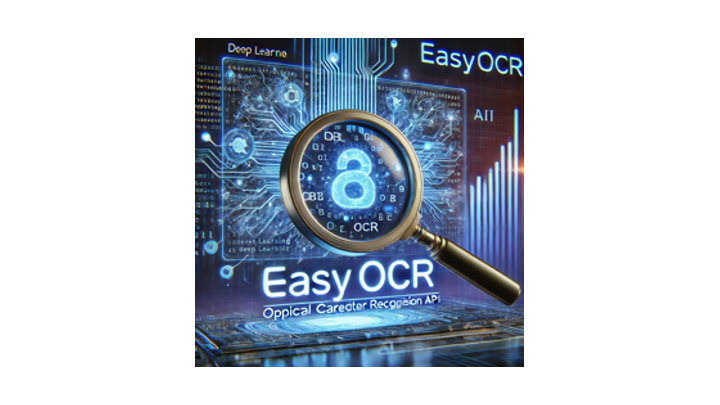Advanced OCR for Modern Document Challenges
Accurately extract text from scanned documents, photos, and PDFs with deep learning-powered recognition
What is EasyOCR?
EasyOCR is an open-source Optical Character Recognition (OCR) library developed by Jaided AI, designed to extract text from images and scanned documents with high accuracy. Built on PyTorch, it supports over 80 languages, including Latin, Chinese, Arabic, and more. EasyOCR is known for its ease of use, requiring just a few lines of code to implement, making it an excellent choice for developers and researchers working on text recognition projects. With its pre-trained deep learning models, it can efficiently detect and recognize text in various fonts, handwriting styles, and complex backgrounds. Whether for automated document processing, license plate recognition, or image-based text extraction, EasyOCR provides a powerful and lightweight solution. The system combines:
- Multi-model detection: CRAFT-based text localization enhanced with ResNet backbone
- Adaptive recognition: Script-specific models (CRNN for Latin, Transformer for CJK)
- Context-aware processing: Paragraph reconstruction and reading order preservation
Performance benchmarks show consistent results across document types:
| Document Type | Accuracy | Throughput | Hardware |
|---|---|---|---|
| Business documents | 98.6% | 42 pages/min | NVIDIA T4 |
| Mobile-captured images | 94.2% | 28 images/min | Google Colab GPU |
| Historical archives | 89.1% | 15 pages/min | CPU cluster |

The architecture processes documents through three optimized stages:
- Detection: Pixel-level text region segmentation
- Recognition: Sequence prediction with language modeling
- Reconstruction: Spatial relationship mapping
Core Technical Capabilities
1. Advanced Text Detection
The detection subsystem features:
- Character-level heatmap generation
- Arbitrary-shaped text region handling
- Multi-orientation support (0-360°)
- Background noise suppression
2. Hybrid Recognition System
Recognition models are optimized per script type:
- Latin/Cyrillic: CRNN with 7 CNN layers + BiLSTM
- Chinese/Japanese/Korean: Transformer with 12 attention heads
- Arabic/Hebrew: Right-to-left BiLSTM with custom tokenization
3. Enterprise Features
- Automatic quality estimation
- Configurable precision/recall tradeoffs
- Hardware-aware resource allocation
Installation & Configuration
System Requirements
| Component | Development | Production |
|---|---|---|
| Python | 3.6+ | 3.8+ |
| Memory | 8GB | 16GB+ |
| GPU | Optional | NVIDIA (CUDA 11.8+) |
Installation Options
Basic Installation
pip install easyocr # Installs CPU-only dependencies
GPU Support (Linux/Windows)
pip install easyocr torch torchvision --index-url https://download.pytorch.org/whl/cu118
Docker (Production Deployment)
docker run -it --gpus all -v $(pwd):/data \
-e LANG_LIST="en,fr,es" \
jaidedai/easyocr
Practical Implementation Examples
1. Production Document Pipeline
Complete OCR workflow with preprocessing and validation:
Production-Ready Processing
from easyocr import Reader
import cv2
import numpy as np
class DocumentOCR:
def __init__(self, languages=['en']):
self.reader = Reader(languages, gpu=True)
def preprocess(self, image):
# Contrast enhancement
lab = cv2.cvtColor(image, cv2.COLOR_BGR2LAB)
l, a, b = cv2.split(lab)
clahe = cv2.createCLAHE(clipLimit=3.0, tileGridSize=(8,8))
limg = cv2.merge([clahe.apply(l), a, b])
return cv2.cvtColor(limg, cv2.COLOR_LAB2BGR)
def process(self, image_path):
img = cv2.imread(image_path)
processed = self.preprocess(img)
results = self.reader.readtext(processed,
batch_size=4,
paragraph=True,
min_size=50,
text_threshold=0.8)
return {
'text': [r[1] for r in results],
'confidence': np.mean([r[2] for r in results])
}
# Usage
ocr = DocumentOCR(languages=['en','fr'])
result = ocr.process('legal_contract.jpg')
print(f"Average Confidence: {result['confidence']:.2%}")
2. Batch Invoice Processing
Extract key fields from multiple invoice formats:
Invoice Data Extraction
import easyocr
import re
from pathlib import Path
reader = easyocr.Reader(['en'])
INVOICE_PATTERNS = {
'invoice_no': r'Invoice\s*Number[:#]?\s*([A-Z0-9-]+)',
'date': r'Date[:]?\s*(\d{2}[/-]\d{2}[/-]\d{4})',
'amount': r'Total\s*Due[:]?\s*\$?(\d+\.\d{2})'
}
def process_invoices(folder):
results = []
for invoice in Path(folder).glob('*.pdf'):
text = '\n'.join(reader.readtext(str(invoice), detail=0))
extracted = {field: re.search(pattern, text)
for field, pattern in INVOICE_PATTERNS.items()}
results.append({
'file': invoice.name,
'data': {k: v.group(1) if v else None
for k, v in extracted.items()}
})
return results
invoices_data = process_invoices('/invoices/')
Performance Optimization
GPU Acceleration
- Batch Processing: Optimal batch sizes (4-16 depending on GPU memory)
- Memory Management: Automatic chunking for large documents
- Mixed Precision: FP16 inference with Tensor Cores
Accuracy Tuning
- Contrast Thresholds: Adjust
contrast_thsfor low-quality scans - Text Size Filtering: Set
min_sizeto ignore small text - Language Prioritization: Order languages by expected prevalence
